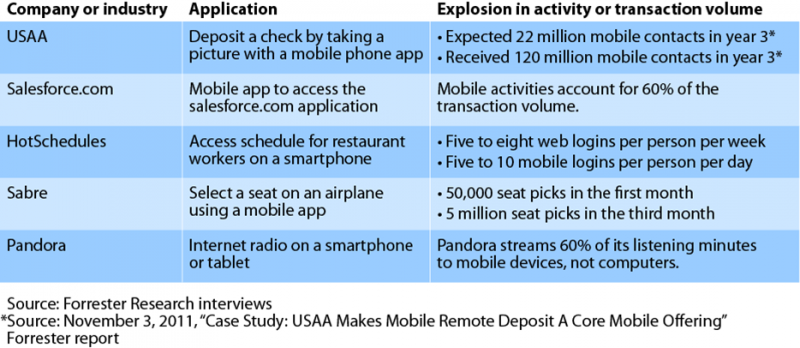Beware Of Mobile’s Unintended Consequences (Part 1)
[This is the second in a series of posts on our report for Forrester clients, "Mobile Is The New Face Of Engagement."]
A successful smartphone app is great, right? Especially when it fronts a system of engagement that lets people click and serve themselves in their moment of need rather than waiting until they can fire up a computer and go online. Or (gasp), dial the phone and tie up some customer service rep's time in India or Africa or Fargo. The mobile engagement is 10 times more convenient than traditional Web and one tenth the cost of a call center contact. So what could possibly go wrong?
In short, just about everything that could go wrong does go wrong when consumer brands, retailers, and B2B companies open up their mobile engagement channel. In this first of several posts on mobile's unintended consequences, we'll describe the unbelievable success that mobile can bring. In future posts, we'll expose the sheer technological ugliness that lies behind those consequences and lay the groundwork for enterprise mobile engagement.
First, the unbelievable success that a mobile app can have (see the figure below):
- USAA expected 22 million mobile contacts in year 3, but got six times that many. With thanks to our colleague Brad Strothkamp, who profiled this example in a Forrester report, here's the skinny on that situation. This banking innovator with a fanatical focus on US military personnel and their families started their mobile banking journey in 2008. But no matter how hard they tried to forecast mobile "contact" growth, the explosion of touchscreen picture phones from Apple and Android thwarted them. People just love the mobile check deposit feature. The big impact has been on new systems of engagement to handle the load. With an eye on a future where mobile traffic exceeds Web traffic (they estimate by 2016), the bank is looking into new mobile scenarios such as P2P payments in partnership with PayPal.
- Salesforce.com gets 60% of its "transaction volume" from mobile devices. This SaaS pure play got mobile religion early with native apps on iPhone and Android. And the mobile traffic reflects that. But it's way ahead of the curve with its "touch." strategy — your application with their hybrid mobile solution ready for tablet deployment in 2012. With the short, sharp nature of mobile transactions — impatient, hurried, and in-the-moment — the front end of Salesforce.com quickly accelerated the move to mobile-optimized RESTful interfaces to handle the load and the static-y mobile connections.
- Restaurant scheduling app iSchedule jacked up HotSchedule logins by 10x, from 5-8 per week to 5-10 per day. When it's easy to do, you do it a lot. That perfectly describes the staffs of HotSchedules' customers like P.F. Changs or Chilis. The HotSchedules mobile team led by the two Matts — CTO Matt Woodings and Director of Software Development Matt Helgren — started small with a scheduling app (that they charge the employee for) with low expectations for success. But mobile demand (and app sales) quickly led them to scale the effort up with native apps for every major mobile platform and beef up the SaaS front end with a crafted interface in a Java container running on Apache Tomcat. The results are clear: a 10x increase (hence much deeper engagement) in logins.
- Travel booking company Sabre saw seat selections expode from 50K to 5M seat picks a month . . . in the first three months. Good thing the mobile architect of the Sabre team, Chito Rosauro, had experience building out the massive VISA network and knew a thing or two about refactoring the middleware to make it scale up in proportion to demand. So he and the Sabre team were ready for the explosive growth in mobile transaction volume.
- Pandora delivers 60% of its music minutes to mobile devices. A native app makes it easy for people to bring all their Pandora stations over to their iPad or Android phone (or many other mobile devices). The match of music and mobile is made in heaven: your music wherever you are on any network that hasn't gacked you out for the same price as you're used to paying for the Web version. When it comes to server planning or Internet acceleration, Pandora's story is not unique: Facebook now gets 30% of its traffic from mobile and Twitter gets 55% from mobile. Their tech teams have had to learn on the fly how to scale up to meet demand: scale-out architectures; tiny XML messages; aggregated Web service calls; JSON, JavaScript, and other Open Web technologies; and sometimes new Web server technology from nginx.
John & I would love to hear your your mobile engagement story. And if social or analytics plays a role, so much the better (see post 1.) Just ping us at tschadler (atta) forrester (you know) com.

